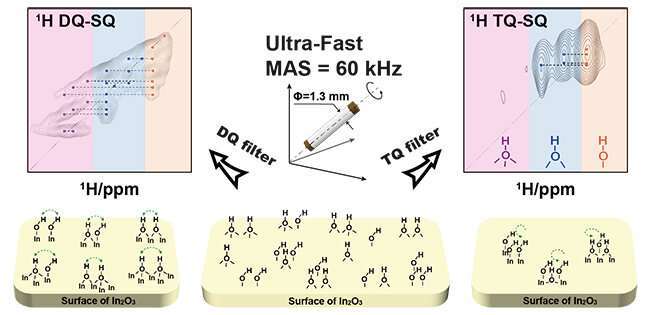Researchers unravel surface hydroxyl network on In2O3 nanoparticles

Hydroxyl groups are among the major active surface sites over metal oxides. However, their spectroscopic characterizations have been challenging due to limited resolutions, especially on hydroxyl-rich surfaces where strong hydroxyl networks are present.
1H solid-state NMR spectroscopy is a powerful technique, owing to its inherent high sensitivity to short-range ordered structures, the superior 1H signal sensitivity afforded by high natural abundance (100%) and high gyromagnetic ratio of the 1H nucleus, as well as the quantitative characteristic for the spin-1/2 nucleus.
Recently, a research team led by Prof. HOU Guangjin from the Dalian Institute of Chemical Physics (DICP) of the Chinese Academy of Sciences (CAS) unraveled the surface hydroxyl network on In2O3 nanoparticles with high-field ultrafast magic angle spinning (MAS) nuclear magnetic resonance (NMR) spectroscopy.
The study was published in Analytical Chemistry on Dec. 8.
The researchers found that at a high magnetic field (18.8 T) and a fast magic angle spinning (MAS) of up to 60 kHz, the much-improved resolution in 1H MAS NMR spectroscopy allowed for resolving nine different surface hydroxyl groups in nano-In2O3 materials.
The nine species were further classified into two kinds of terminal hydroxyl, four kinds of doubly bridged hydroxyl, and three kinds of triply bridged hydroxyl moieties with the assistance of 17O-based NMR analysis.
Moreover, they conducted 2D 1H-1H SQ-SQ, DQ-SQ and TQ-SQ homonuclear correlation experiments to reveal detailed information about the spatial proximity among hydroxyl groups in such complex surface environments.
Through quantitative 1H NMR analyses, they investigated the thermal stability and reactivity of these hydroxyl groups, which provided better understanding on the surface structures of In2O3 nanoparticles in their catalytic performance.
"This work will prompt more extensive applications in many other metal oxide materials that share similar and complex surface hydroxyl networks," said Prof. Hou.
More information: Qiao Han et al, Unraveling the Surface Hydroxyl Network on In2O3 Nanoparticles with High-Field Ultrafast Magic Angle Spinning Nuclear Magnetic Resonance Spectroscopy, Analytical Chemistry (2021). DOI: 10.1021/acs.analchem.1c02759
Journal information: Analytical Chemistry
Provided by Chinese Academy of Sciences




















